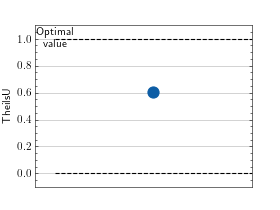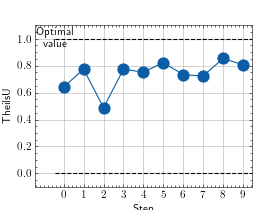Theil’s U¶
Module Interface¶
- class torchmetrics.nominal.TheilsU(num_classes, nan_strategy='replace', nan_replace_value=0.0, **kwargs)[source]¶
Compute Theil’s U statistic measuring the association between two categorical (nominal) data series.
\[U(X|Y) = \frac{H(X) - H(X|Y)}{H(X)}\]where \(H(X)\) is entropy of variable \(X\) while \(H(X|Y)\) is the conditional entropy of \(X\) given \(Y\). It is also know as the Uncertainty Coefficient. Theils’s U is an asymmetric coefficient, i.e. \(TheilsU(preds, target) \neq TheilsU(target, preds)\), so the order of the inputs matters. The output values lies in [0, 1], where a 0 means y has no information about x while value 1 means y has complete information about x.
As input to
forwardandupdatethe metric accepts the following input:preds(Tensor): Either 1D or 2D tensor of categorical (nominal) data from the first data series (called X in the above definition) with shape(batch_size,)or(batch_size, num_classes), respectively.target(Tensor): Either 1D or 2D tensor of categorical (nominal) data from the second data series (called Y in the above definition) with shape(batch_size,)or(batch_size, num_classes), respectively.
As output of
forwardandcomputethe metric returns the following output:theils_u(Tensor): Scalar tensor containing the Theil’s U statistic.
- Parameters:
num_classes¶ (
int) – Integer specifying the number of classesnan_strategy¶ (
Literal['replace','drop']) – Indication of whether to replace or dropNaNvaluesnan_replace_value¶ (
Optional[float]) – Value to replaceNaN``s when ``nan_strategy = 'replace'kwargs¶ (
Any) – Additional keyword arguments, see Advanced metric settings for more info.
Example:
>>> from torchmetrics.nominal import TheilsU >>> _ = torch.manual_seed(42) >>> preds = torch.randint(10, (10,)) >>> target = torch.randint(10, (10,)) >>> metric = TheilsU(num_classes=10) >>> metric(preds, target) tensor(0.8530)
- plot(val=None, ax=None)[source]¶
Plot a single or multiple values from the metric.
- Parameters:
val¶ (
Union[Tensor,Sequence[Tensor],None]) – Either a single result from calling metric.forward or metric.compute or a list of these results. If no value is provided, will automatically call metric.compute and plot that result.ax¶ (
Optional[Axes]) – An matplotlib axis object. If provided will add plot to that axis
- Return type:
- Returns:
Figure and Axes object
- Raises:
ModuleNotFoundError – If matplotlib is not installed
>>> # Example plotting a single value >>> import torch >>> from torchmetrics.nominal import TheilsU >>> metric = TheilsU(num_classes=10) >>> metric.update(torch.randint(10, (10,)), torch.randint(10, (10,))) >>> fig_, ax_ = metric.plot()

>>> # Example plotting multiple values >>> import torch >>> from torchmetrics.nominal import TheilsU >>> metric = TheilsU(num_classes=10) >>> values = [ ] >>> for _ in range(10): ... values.append(metric(torch.randint(10, (10,)), torch.randint(10, (10,)))) >>> fig_, ax_ = metric.plot(values)

Functional Interface¶
- torchmetrics.functional.nominal.theils_u(preds, target, nan_strategy='replace', nan_replace_value=0.0)[source]¶
Compute Theils Uncertainty coefficient statistic measuring the association between two nominal data series.
\[U(X|Y) = \frac{H(X) - H(X|Y)}{H(X)}\]where \(H(X)\) is entropy of variable \(X\) while \(H(X|Y)\) is the conditional entropy of \(X\) given \(Y\).
Theils’s U is an asymmetric coefficient, i.e. \(TheilsU(preds, target) \neq TheilsU(target, preds)\).
The output values lies in [0, 1]. 0 means y has no information about x while value 1 means y has complete information about x.
- Parameters:
preds¶ (
Tensor) – 1D or 2D tensor of categorical (nominal) data - 1D shape: (batch_size,) - 2D shape: (batch_size, num_classes)target¶ (
Tensor) – 1D or 2D tensor of categorical (nominal) data - 1D shape: (batch_size,) - 2D shape: (batch_size, num_classes)nan_strategy¶ (
Literal['replace','drop']) – Indication of whether to replace or dropNaNvaluesnan_replace_value¶ (
Optional[float]) – Value to replaceNaN``s when ``nan_strategy = 'replace'
- Return type:
- Returns:
Tensor containing Theil’s U statistic
Example
>>> from torchmetrics.functional.nominal import theils_u >>> _ = torch.manual_seed(42) >>> preds = torch.randint(10, (10,)) >>> target = torch.randint(10, (10,)) >>> theils_u(preds, target) tensor(0.8530)
theils_u_matrix¶
- torchmetrics.functional.nominal.theils_u_matrix(matrix, nan_strategy='replace', nan_replace_value=0.0)[source]¶
Compute Theil’s U statistic between a set of multiple variables.
This can serve as a convenient tool to compute Theil’s U statistic for analyses of correlation between categorical variables in your dataset.
- Parameters:
matrix¶ (
Tensor) – A tensor of categorical (nominal) data, where: - rows represent a number of data points - columns represent a number of categorical (nominal) featuresnan_strategy¶ (
Literal['replace','drop']) – Indication of whether to replace or dropNaNvaluesnan_replace_value¶ (
Optional[float]) – Value to replaceNaN``s when ``nan_strategy = 'replace'
- Return type:
- Returns:
Theil’s U statistic for a dataset of categorical variables
Example
>>> from torchmetrics.functional.nominal import theils_u_matrix >>> _ = torch.manual_seed(42) >>> matrix = torch.randint(0, 4, (200, 5)) >>> theils_u_matrix(matrix) tensor([[1.0000, 0.0202, 0.0142, 0.0196, 0.0353], [0.0202, 1.0000, 0.0070, 0.0136, 0.0065], [0.0143, 0.0070, 1.0000, 0.0125, 0.0206], [0.0198, 0.0137, 0.0125, 1.0000, 0.0312], [0.0352, 0.0065, 0.0204, 0.0308, 1.0000]])
